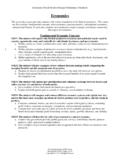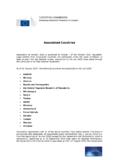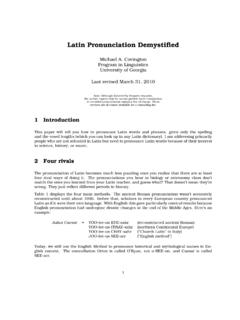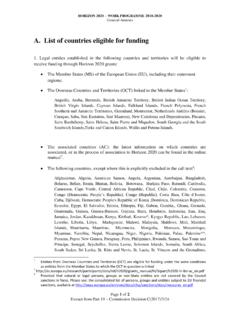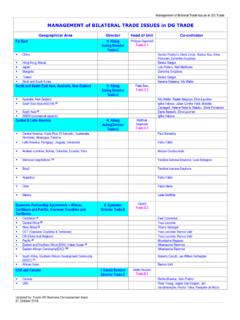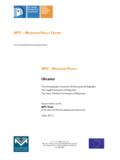Transcription of Phage Therapy: Past History and Future Prospects
1 Archivum Immunologiae et Therapiae Experimentalis, 1999, 47, 267 274PL ISSN 0004-069 XReviewPhage therapy : past History and Future ProspectsR. M. Carlton: Phage therapy in the past and FutureRICHARD M. CARLTONE xponential Biotherapies, Inc., 150 Main Street, Port Washington, NY 11050, USAA bstract. Bacterial viruses (bacteriophages, also called phages ) can be robust antibacterial agents in , their use as therapeutic agents, during a number of trials from the1920s to the 1950s, was greatlyhandicapped by a number of factors. In part, there were certain limitations inherent in Phage physiology (e.)
2 G. nar-row host range, and rapid clearance from the body); in part there were technological limitations in the era( lysogeny not yet discovered); but the greatest limitation was the highly inadequate scientific methodologiesused by practitioners at the time ( , their failure to conduct placebo-controlled studies, to remove endotoxinsfrom the preparations, and to re-confirm Phage viability after adding sterilizing agents to the preparations). Inrecent years, well-controlled animal models have demonstrated that phages can rescue animals from a variety offatal infections, while non-controlled clinical reports published in Eastern Europe have shown that phages can beeffective in treating drug-resistant infections in humans.
3 This encouraging data, combined with the fact thatdrug-resistant bacteria have become a global crisis, have created a window of opportunity for Phage therapy tobe tested anew, this time using modern technologies and placebo-controlled designs. If successful, it can be usedas a stand-alone therapy when bacteria are fully resistant to antibiotics, and as a valuable adjunct to antibioticswhen the bacteria are still words: bacteriophage; Phage ; bacterial viruses; bacterial infections; multidrug are a kingdom of viruses that infect bacteria,and are distinct from the animal and plant can have either a lytic or a lysogenic lifecycle.
4 The lytic phages are the most suitable candidatesfor Phage therapy , because they quickly reproducewithin and lyse the bacteria in their host range, growingexponentially in number in the process. Depending onthe species and conditions, each parent Phage canproduce on average approximately 200 daughters perlytic cycle. If each daughter infects and kills a hostbacterium there will be 40 000 progeny at the end ofthe 2nd cycle; 8 million at the end of the 3rd cycle; at the end of the 4th cycle; and so practitioners used phages as therapeuticagents in the West, from the 1920s to the early 1950s(referred to hereinafter as the historic era ).
5 This re-view will describe: 1) some of the key reasons thisform of therapy failed to take root in the West; 2) itsprevious and current use in some enclaves of EasternEurope; 3) recent animal models which suggest thatphage therapy might be useful for humans; 4) the factthat the emergence of antibiotic-resistant infections hasopened a second window of opportunity for Phage ther-apy; and 5) the advantages that might be gained byadministering phages along with antibiotics, as a com-bination HistoryGeneral informationA number of reviews provide details on Phage ther-apy s ascent and decline in the historical era1 3, 13, will summarize some of the more salient featuresof this were discovered in 1915 by British micro-biologist Felix Twort, and, independently in 1917,by French-Canadian microbiologist Felix d H did not pursue his discovery.
6 Whereas d H rellesystematically investigated the nature of bacteriophagesand explored their ability to function as therapeuticagents5, H relle received a fair measure of fame for hisdiscovery. He was appointed Professor of Protobiologyat Yale University Medical Center, and was also on thestaff of the Pasteur Institute. In 1931 he gave a seriesof monthly lectures on Phage therapy to the New YorkAcademy of Medicine. He established Phage therapycenters in several countries, including the U. S., France,and Soviet Georgia. A fictionalized account of his workwas depicted in Arrowsmith, the Pulitzer-prize winningnovel by Sinclair are many attributes of phages (see Table 1)that would tend to favor a positive outcome in these attributes of phages, there were somany problems with the way Phage therapy was prac-ticed in the historical era that, by the time antibioticswere introduced in mid-century, it was already in sharpdecline in the West.
7 The investigators who developedantibiotics did not make the kinds of mistakes exhibitedby the early Phage problems with Phage therapy , and how the problems can be overcomeProblem 1. Host rangeThe issue. Phages tend to have a relatively narrowhost range, posing certain disadvantages. A disadvant-age is that one should administer only those phagestrains shown to be strongly lytic for the bacterial straininfecting the given patient. If the patient s condition istoo critical to take the time required for this matching,then one should use a grouping (a panel) of phages,where each of the phages therein has a broad-enoughhost range that most strains of the bacterial target arelikely to be targeted.
8 In his lectures to the New YorkAcademy of Medicine in 1931, d H relle cited the re-ports of other colleagues whose initial trials usedphages off the shelf (without being shown to be viru-lent for the bacteria infecting the patient) and had ne-gative outcomes, but who did match the Phage to thebacteria in subsequent trials and obtained positive solution. 1) Screen the bacteria infectinga given patient against a panel of phages, to ensure thatone of the Phage strains will be lytic (analogous to the culture and sensitivity test that physicians should per-form; and 2) develop multivalent phages that lyse allor most of the bacterial strains within a given speciesof 1.
9 Attributes of phages that tend to favor a therapeutic responseThe issueLimitations of antibioticsAdvantages of phagesFate of the drug moleculeConcentration of the drug required to kill a givenbacterium within the spectrumAbility to overcome bacterialresistanceSpread of bacterial resistanceMetabolic destruction of the molecule, as itworksNumerous molecules of the antibiotic are neededto kill a given bacterium. During initiation oftherapy (and between doses), the sub-lethal dosethat bacteria see affords them the opportunityto express resistance genesAntibiotics are fixed, immutable chemicals thatcannot adapt to a bacterial mutation andtherefore become obsolete.
10 Bacteria that haveresisted them can pass along the resistance traitwithin and between speciesThe antibiotics in use tend to be broad spectrum,thereby provoking resistance in several speciesand genera of bacteria (in addition to the onetargeted)Exponential growth in numbers, so that the drug makes more of itself at the site ofinfection, where it is needed All or nothing effect: one Phage particle issufficient to kill a given bacteriumPhages are living organisms that undergomutations, some of which can overcomebacterial mutations. E. g., mutated Phage tailfibers can allow binding to a mutant bacterialreceptor, or mutated Phage DNA can escapecleavage by mutant bacterial endonucleasesAlthough there are some exceptions, phages tendnot to cross species boundaries.
